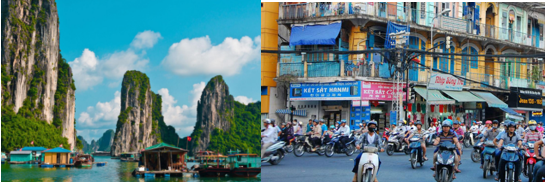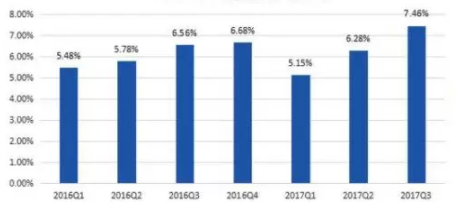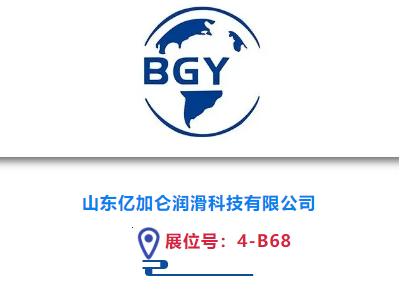On March 18, 2018, Liao Changrong, general manager of CLIMAVENETA Chat Union Group, announced the plan to build a factory in Vietnam and the ribbon-cutting ceremony at the HVACR Vietnam 2018. On June 1st, Wolong Electric's first overseas factory was successfully put into operation in Vietnam's Haiphong Shenyue Industrial Park, which will become the headquarters of Southeast Asia. Daikin Air Conditioning Vietnam Company (located in Ho Chi Minh City, Socialist Republic of Vietnam)'s factory was completed in June in the suburbs of Hanoi, Vietnam, and officially put into production. In 2018, South Korea's LG, Ningbo Jintian and other refrigeration companies will be put into production in Vietnam, which will further establish Vietnam's status as a new global air-conditioning producer.

Status of refrigeration enterprises that have established factories in Vietnam
Haier has a factory in Ho Chi Minh City, Vietnam, with a capacity of 300,000 sets. It mainly produces split-type air conditioners, of which inverters account for about 55%. It can also produce light commercial products below 5 hp. Haier Vietnam is mainly engaged in the assembly of air-conditioning products. After Haier acquired Sanyang, the Aqua brand was used in Vietnam for electrical appliances such as refrigerators and air conditioners. The proportion of R32 air conditioners in Haier Vietnam is about 40%, and R32 refrigerant will be used all next year. The annual sales volume of Haier Vietnam is about 100,000 to 150,000 sets, and more than 95% of them are single cold machines.
Midea built an air-conditioning plant in Pingyang, Vietnam in 2007. The next year, air-conditioning production began. Now, the air-conditioning capacity is 1 million units and the refrigerator capacity is 500,000 units. Air-conditioning products include window machines and split machines. Air conditioners of more than 3 hp are mainly imported from China, and air-conditioning production capacity is radiated to neighboring countries. Air conditioning is mainly based on R410A, and R32 products will be launched this year. At present, the frequency conversion is 10%, mainly the single cold frequency conversion. Midea's home air conditioners have more than 1,200 terminal outlets in Vietnam. Midea's commercial air conditioners are mainly based on engineering companies in Vietnam, and there are relatively few agents. In the VRF pre-sales service, Midea arranged technical personnel to conduct technical training for the engineering company from time to time. For after-sales, through the various outlets, the project process is supervised and the three strategic regions of North, Central and South are divided. In the Vietnamese market, Midea's household air-conditioning products have taken root, and commercial air-conditioning channels have been opened and are constantly being developed. Midea’s goal for this year is to achieve a 7% share of the Vietnamese market.
Hisense has an independent office in Vietnam. For the Vietnamese market, Hisense only does VRF. In the Vietnamese market, Hisense firstly grasps the quality of its products, and secondly provides a full range of services and support for commercial air conditioners, providing customers and distributors with a full range of solutions. Hisense Vietnam was established in 2016. The first project is cooperated with Vietnam's largest real estate developer in 2017 which is 1000 hp in Xin'an. Then there was a 2700 hp school project and Hui'an 1400 hp a five-star resort project. At the same time, some government projects were taken, including the air-conditioning project of the United Nations headquarters building in Hanoi. Hisense's goal is to enter the Top 3 of the Vietnamese market for three years.
Panasonic has a home appliance production base in Vietnam, but there is currently no air conditioning production base. Air-conditioning products are mainly imported from Malaysia and Thailand. Panasonic has a long history of entering Vietnam and has been working in Vietnam for more than 20 years. Especially among older consumers, Panasonic's household air conditioners have a high brand awareness, even among Japanese brands. Panasonic has more than 2,000 distributors. There are more than 100 dealers selling directly. Panasonic's sales in the Red River Delta region are very strong and take root in the rural market.
Moon Group, as the leader in China's air-conditioning compressor and industrial refrigeration industry, established Yantai Moon (Vietnam) Co., Ltd. in Vietnam in 2006. For more than ten years, Moon Group has not only harvested a stable customer base in the Vietnamese market. At the same time, localization of production, localization of sales and localization of services are realized. Today, Yantai Moon Vietnam Co., Ltd is almost Vietnamese from production to sales to service. This brand has also become a private brand recognized by Vietnam.
Hailiang Group established Hailiang (Vietnam) Copper in 2010 and settled in Longjiang Industrial Park, Vietnam. Hailiang (Vietnam) Copper Co., Ltd. has shown a very good development trend in recent years. In 2016, the company's output value was 170 million US dollars, 2017 was 349 million US dollars, and this year is expected to be 450 million US dollars. In 2015, the output of copper pipe and deep processing products was 26,000 tons, 39,000 tons in 2016 and 49,000 tons in 2017. It is expected to reach 60,000 tons this year. At present, 100% of the products produced by Hailiang (Vietnam) are exported. The sales of copper processing products produced by Hailiang (Vietnam) enterprises in the United States reached 20,000 tons, and the Indian market accounted for 70%. On the basis of consolidating the Asian market, the company's products successfully developed markets in South America, the European Union, etc., and became the supplier of internationally renowned air conditioners enterprises' key refrigeration components.
A new star in the Southeast Asian market - Vietnam
The rapid growth of foreign trade in Southeast Asia has attracted global attention. It is estimated that by 2020, the population of Southeast Asia will reach 700 million. The main battlefield of multinational companies has shifted to the Asian region, especially the Southeast Asian market. The world's top companies have taken a fancy to this huge market. Among the countries with new economies in Southeast Asian, Vietnam is considered to be the most promising strategic focus.
1. Political stability and rapid economic growth
In recent years, with Vietnam's domestic political stability, sustained high-speed economic growth, and implementing reform and opening up policies, the investment environment has been continuously optimized, attracting many foreign investment. According to the statistics of the General Statistics Bureau of Vietnam, Vietnam's economic growth in the first nine months of 2017 was 6.41%, of which the first quarter increased by 5.15%, the second quarter increased by 6.28%, and the third quarter increased by 7.46%. Vietnamese economists predict that if the current growth rate is maintained, Vietnam is expected to achieve the 6.7% economic growth target set for the whole year. At the same time, the total amount of foreign investment attracted by the first nine months reached 25.48 billion US dollars (more than the full year of 2016), an increase of 34.3%.

2. The population is large and the geographical position is superior
Vietnam covers an area of 330,000 square kilometers,bordering China to the north, bordering Laos and Cambodia in the west, facing the South China Sea in the east and south, facing the Malaysian, Singapore, Indonesia, Philippines, and Thailand, and affecting neighboring countries strongly. Vietnam's current population of 92.7 million (2016), with low average wages and the large amount of labor required by factories, is the reasons why many factories are attracted to invest in this.

3. The rapid development of the economy drives the rapid development of the real estate industry
In recent years, with the rapid development of Vietnam's economy, the real estate industry has developed rapidly too. The whole of Vietnam, like China around the year of 2000, is full of construction sites. It is an exaggeration that a building materials exhibition in Vietnam is held eight times a year, which is unique in the world and fully demonstrates the rapid development of the real estate industry.
The rapid development of the real estate industry has also spawned a huge market demand for the air conditioning and refrigeration industry. In the Vietnamese air-conditioning market, the penetration rate of household air conditioners averages 4%. Currently in the urban area, this figure exceeds 10%, which shows that with the growing income of Vietnamese people, the market prospects are very impressive. As an important commercial center in southern Vietnam, Ho Chi Minh City's household air-conditioning market accounts for about 30% of the country. In 2017, the HVACR Vietnam Expo attracted the active participation of global refrigeration manufacturers, resulting in serious shortage of booths. They all hope to quickly enter the Vietnamese market with the help of the exhibition.
4. Vietnam is constantly expanding its opening up policy
In recent years, Vietnam has continuously expanded its opening-up policy and created good international trade opportunities for its manufacturing industry. It has become the country with the largest number of free trade agreements in Asia, especially the Vietnam-EU Free Trade Area, which will be implemented in 2019. It will created favorable conditions for exporting products made in Vietnam. To this end, the Chinese Economic Counselor in Vietnam published an article "Chinese Enterprises Tightly Take the Opportunity of Vietnam-EU Free Trade Agreement to Expand Investment in Vietnam".
It is believed that in the near future, Vietnam will become an important production base for global air-conditioning equipment, but due to the insufficiency of the industrial chain, it will create excellent trading opportunities for Chinese air-conditioning parts companies.
Vietnam and China - Vietnam becomes China's largest trading partner in ASEAN
According to data released by the General Statistics Office of Vietnam at the end of 2017, Vietnam’s trade was in a surplus situation in 2017, with a surplus of US$2.7 billion, and Vietnam’s import and export volume exceeded US$400 billion, a record of innovation.
Specifically, in 2017, Vietnam’s national merchandise exports amounted to approximately US$213.77 billion, a year-on-year increase of 21.1%, a record high for many years. Among them, China reached US$35.3 billion, an increase of 60.6%, ranking third.
On the other hand, Vietnam's 2017 national merchandise imports amounted to approximately US$211.1 billion, a year-on-year increase of 20.8%. China is still the largest import market in Vietnam, with imports reaching US$58.5 billion, a year-on-year increase of 16.9%;
And as early as May, Coowor.com calculated the data of the major 40 countries in China's foreign trade in 2017 based on relevant data. The data shows that Vietnam is the top ten country in China's total bilateral trade, with an increase of 30.2%, ranking ninth. The performance is quite eye-catching. Moreover, no matter whether it is China's top ten countries and regions for export, or the top ten countries and regions with China's export growth rate, Vietnam has been on the list.
Recently, the Philippine media reported that Vietnam became China's largest trading partner in ASEAN for the first time in 2018. In 2018, the bilateral trade exceeded 10 billion U.S. dollars per month. According to the "Philippine Daily Inquirer" website reported on July 29, Hu Zhanjin, economic and commercial counselor of the Chinese Embassy in Vietnam, said at a special press conference on Sino-Vietnamese economic and trade cooperation that the total economic and trade volume between China and Vietnam in June 2018 reached 11.2 billion U.S. dollars. More than China's and Malaysia's $9.3 billion. Malaysia has been China's largest ASEAN trading partner for many years.
According to the report, in the first half of this year, Sino-Vietnamese bilateral trade increased by 28.8% year-on-year, exceeding China's 15.5% growth rate in ASEAN's second largest trading partner, Malaysia. And Hu Sujin emphasized that this is the "best period of history" in the economic relations between the two countries.
Yin Haihong, the Chargé d’affaires of the Chinese Embassy in Vietnam, also announced that the two sides will have several high-level visits in the second half of this year and said that the Embassy will do its best to encourage capable Chinese companies to invest in Vietnam.






















